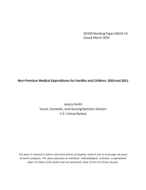
An official website of the United States government
Here’s how you know
Official websites use .gov
A .gov website belongs to an official government organization in the United States.
Secure .gov websites use HTTPS
A lock (
) or https:// means you’ve safely connected to the .gov website. Share sensitive information only on official, secure websites.
-
//
- Census.gov /
- Census Working Papers /
- Non-Premium Medical Expenditures for Families and Children
Non-Premium Medical Expenditures for Families and Children: 2010 and 2011
Non-Premium Medical Expenditures for Families and Children: 2010 and 2011
Introduction
Although medical spending began to show minor decreases before the recession, since that time, rising unemployment rates, corresponding declines in employment-based health insurance, and rising health insurance premiums (pricing individuals out of coverage) have caused people to further cut back on medical services, therefore lowering their out-of-pocket costs (Seaman, 2013; Families USA, 2012). There has been a downward trend in visits to doctors’ offices, hospitalizations, and the number of prescriptions filled. Not surprisingly, this decrease in the use of medical services can create problems for an individual’s health; as an individual forgoes preventive care, this could lead to a loss of early detection of illness and disease (Seaman, 2013).
Past studies have shown that lack of health insurance for children can lead to poorer health in childhood (Baker, 2009). As with adults, uninsured children are more likely to forgo needed medical care, such as childhood immunizations and routine medical and dental check-ups (Families USA, 2009). In 2011, approximately 1.3 million children were unable to get needed medical care because the family could not afford it, and medical care was delayed for 2.5 million children due to concerns about the costs (Bloom, Cohen, and Freeman, 2011).
This research examines the relationships between health insurance status, medical out-of-pocket expenditures, and other demographic, social and economic characteristics for all people, children, and families. It can be expected that individuals with private coverage will have higher expenditures than those with government coverage, such as Medicaid, since private coverage is associated with premiums, copays, and other out-of-pocket expenses that can quickly add up. Expenditures for those with Medicare will likely fall somewhere in between.
Share
Related Information
WORKING PAPER
Health Insurance Working PapersSome content on this site is available in several different electronic formats. Some of the files may require a plug-in or additional software to view.
 Yes
Yes
 No
NoComments or suggestions?


Top

